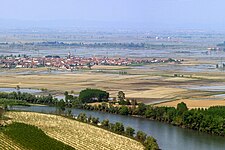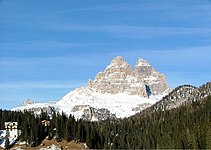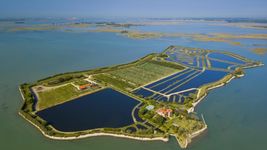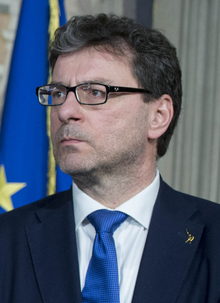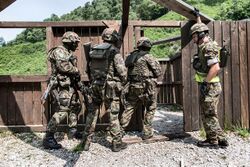Cavarzere: Difference between revisions
| Line 206: | Line 206: | ||
The [[Most Serene Armed Forces|armed forces]] have three branches: [[Most Serene Navy|Navy]], [[Most Serene Army|Army]] and [[Most Serene Air Force|Air Force]]. They serve primarily as a self-defense force whose mission is to protect the territorial integrity of the country and provide humanitarian assistance and security at home and abroad. As of 2008, the three branches numbered 59,200 active personnel including 7,500 women. Cavarzerian military expenditure in 2017 was $11 billion, representing 3.1 percent of GDP. Military conscription was abolished in 2004. The minimum age for voluntary recruitment is 18 years. | The [[Most Serene Armed Forces|armed forces]] have three branches: [[Most Serene Navy|Navy]], [[Most Serene Army|Army]] and [[Most Serene Air Force|Air Force]]. They serve primarily as a self-defense force whose mission is to protect the territorial integrity of the country and provide humanitarian assistance and security at home and abroad. As of 2008, the three branches numbered 59,200 active personnel including 7,500 women. Cavarzerian military expenditure in 2017 was $11 billion, representing 3.1 percent of GDP. Military conscription was abolished in 2004. The minimum age for voluntary recruitment is 18 years. | ||
[[File:EACGF.jpg|250px|thumb|right|Soldiers of the Most Serene Army on training exercises.]] | |||
The Most Serene Army (36,000 personnel) comprises five brigades and other small units. An infantry brigade (mainly equipped with XXX APC), two mechanized brigades (mainly equipped with XXX tanks and XXX APC) and a Rapid Reaction Brigade (consisting of Paratroopers, commandos and Rangers). The Navy (15,700 personnel, of which 1,580 are marines), one of the world's oldest surviving naval force, has eight frigates, ten corvettes, four submarines, and 28 patrol and auxiliary vessels. The Air Force (7,500 personnel) has the XXXX and the XXXX as the main combat aircraft. | The Most Serene Army (36,000 personnel) comprises five brigades and other small units. An infantry brigade (mainly equipped with XXX APC), two mechanized brigades (mainly equipped with XXX tanks and XXX APC) and a Rapid Reaction Brigade (consisting of Paratroopers, commandos and Rangers). The Navy (15,700 personnel, of which 1,580 are marines), one of the world's oldest surviving naval force, has eight frigates, ten corvettes, four submarines, and 28 patrol and auxiliary vessels. The Air Force (7,500 personnel) has the XXXX and the XXXX as the main combat aircraft. | ||
Revision as of 22:41, 28 May 2019
This article is incomplete because it is pending further input from participants, or it is a work-in-progress by one author. Please comment on this article's talk page to share your input, comments and questions. Note: To contribute to this article, you may need to seek help from the author(s) of this page. |
Most Serene and Auspicious Republic of Cavarzere Serenìsima è Auspixio Repùblica Cavarsère | |
|---|---|
Motto:
| |
Anthem:
| |
| Capital | Cavarzere |
| Largest city | Brondolo |
| Official languages | Cavarzerian |
| Demonym(s) | Cavarzerian |
| Government | Unitary oligarchic elective monarchy |
• Doge | Leonardo Dondorana |
| Teodato Mastropiero | |
| Bartolomeo Dondorana | |
| Legislature | Great Council of the Most Serene |
| Council of Thirteen | |
| Signoria | |
| Independence from the Latin Empire | |
• Independence from Latium | 1062 |
• Council of Seven | 1135 |
• Devotion of Brondolo to Cavarzere | 1235 |
• Devotion of the Three Cities | 1310 |
• Devotion of Cavarzere to the Dondodara | 1867 |
• Current constitution | 2005 |
| Area | |
• | 56,928 km2 (21,980 sq mi) |
| Population | |
• 2018 estimate | 9,887,404 |
• 2010 census | 9,126,333 |
• Density | 173.68/km2 (449.8/sq mi) |
| GDP (PPP) | estimate |
• Total | $384.12 billion |
• Per capita | $38,850 |
| GDP (nominal) | estimate |
• Total | $357.67 billion |
• Per capita | $36,175 |
| Gini | 50.8 high |
| HDI | 0.863 very high |
| Currency | Florin (ƒ) |
| Date format | dd.mm.yyyy |
| Driving side | left |
Cavarzere (Cavarzerian: Cavarsère), officially the Most Serene and Auspicious Republic of Cavarzere (Cavarzerian: Serenìsima è Auspixio Repùblica Cavarsère) is a unitary elective constitutional monarchy, located in southern Belisaria. The country covers an area of 56,928 km2 (21,980 sq mi) and shares open land borders with Latium to the west and Lihnidos to the north, and is bound by the Gulf of Cavarzere to the south. Cavarzere has a maritime territory on the islands of Dorsoduro off the coast of Scipia and east of Sydalon. With around 9.8 million inhabitants, it is the smallest member state of the Belisarian Community.
History...
Today, Cavarzere has the Xth largest economy in the world. As an advanced economy the country is home to high human development and life expectancy. Despite its size, the country plays a major role in regional and global cultural, political, religious and diplomatic affairs. It is a member of the Belisarian Community, the Perilcean Forum and the Organization of Latin States.
History
Pre-classical
Latin period
Independence
Middle Ages
Renaissance
Early modern
Present
Geography
Cavarzere is the Xth largest region in Belisaria, with a total area of 56,928 km2 (21,980 sq mi). It is located in the southern Belisaria, bordered by Latium to the west and north-west, Lihnidos to the north and north-east and the Gulf of Cavarzere to the south.
Much of Cavarzere exists within the Łivensa Basin, as such it is dominated by hills and flatlands. However, by area, 29% of its surface is mountainous, comprised mostly of the Rovolon mountains, in the north along the border with Latium. The highest massif in the Rovolons is the Rivodolmo-massif at 3,342 m (10,965 ft). Other rovolonic peaks are the Tri Žima di Dobbiaco and the Sass Màor. A distinctive characteristic of the Rovolon peaks are the cave formations, including chasms and sink holes; the Bocca de Terra, situated in the Žima Cajari chain in the comun of Froxinon, has an explored depth of 997 m (3,271 ft), being the deepest cave in Cavarzere. Fossil deposits are also abundant there.
The Łivensa Basin, covering 57% of Cavarzere, extends from the mountains to the Gulf of Cavarzere, broken only by some low hills: San Lorenzso Hills, Canpanièl Hills Colli Arxento and Silensiose, which constitute the remaining 14% of the territory. The plain itself is subdivided into the higher plain (gravel-strewn and not very fertile) and the lower plain (rich in water sources and arable terrain). The lower plain is both a mainstay of agricultural production and the most populated part of the region.
Several rivers flow through the region: the Bresanvido, Àdexe, Trichiana, Limana, and Pialdier. Western Cavarzere is dominated by Lake Solarolo, which has a 200km long shore, 134km of which is sand or gravel beach.
The coast of Cavarzere is characterised by the Cavarzerian Lagoon, a flat terrain with ponds, marshes and islands. The Àdexe Delta to the south features sandbars and dunes along the coastline. The inland portion contains cultivable land recently reclaimed by a system of canals and dykes. Fish ponds have been created there as well. The delta and the lagoon are a stopping-point for migratory birds.
The Àdexe river running through Chievo
The Caxa de Łaguna on the Cavarzerian Lagoon
Climate
The climate changes significantly from one area to another: while it is continental on the plains, it is milder along the Cavarzeric coast; around the Lake Solarolo and in the hilly areas. The lowlands are often covered by thick fog; precipitations that are scarce - 750 mm per year - next to the river Àdexe, are more abundant - from 750 to 1100 mm per year - at higher altitudes; the highest values - up to 3200 mm per year - are recorded in the Rivodolmo, near Žima de San Marco and on the Arxento plateau.
Government and politics
Cavarzere is a unitary state under a elective constitutional monarchy. Cavarzere's constitution, adopted in 1867 and amended a number of times since, is the legal framework that governs the monarch, government, bicameral legislature and judiciary. The Doge retains wide executive and legislative powers from the government and parliament. The doge exercises his powers personally and through the government that he appoints for a four-year term, which is responsible before the parliament that is made up of two chambers: the Council of Thirteen and the Signoria. The judiciary is independent according to the constitution.
The doge is the head of state and commander-in-chief of the armed forces. He can declare war and peace, ratify laws and treaties, convene and close legislative sessions, call and postpone elections, dismiss the government and dissolve the parliament. The appointed government can also be dismissed through a majority vote of no confidence by the elected Signoria. After a bill is proposed by the government, it must be approved by the Signoria then the Council of Thirteen, and becomes law after being ratified by the Doge. A ducal veto cannot be overridden. The parliament also has the right of interpellation.
The Prime Minister serves as the head of government due to its role as the leader of the cabinet; however, cabinet is chaired by the Doge, when he is present. The Prime Minister serves as the Doge's chief government minister, and presiding officer of the Signoria. Historically, the Prime minister was not responsible to the Signoria, but solely to the Doge or Council of Thirteen. Since the 20th century, the Prime Minister is typically the leader of the largest party or group of parties in the Signoria, causing the sitting prime minister to hold both the confidence of the Doge and a majority of the Signoria.
The 13 members of the upper Council of Thirteen are the chosen representatives of the country's wealthiest patrician families, and the seats are held for life. The 70 members of the lower Signoria are elected through first-past-the-post in 22 constituencies for a 4-year term.
According to the Forum of Nations, Cavarzere's political system is highly oligarchical and exclusive, with power centralised around the thirteen wealthiest families, at the expense of popularly elected assemblies.
Doge
The position of the Doge of Cavarzere (Doxe de Cavarsère) traces its origins to Dioclexiano Cavarseran, a Latin noble who led the city-state in securing independence from the Latin Empire in 1062. Prior, he served as Duke of Cavarserium, where upon independence, he opted to maintain his rank, adopting the title Doxe, a translation of Duce in the local dialect.
From 1062 until 1135, the Doge ruled as an absolute monarch, only taking the advice and interjections of the wealthiest and most prominent patrician families through the Great Council of the Lagoon. In 1135, the Council of Seven devised a quasi-constitution, establishing numerous assemblies to check the Doge's power. By the 16th century, the Doge had come to depend upon the various assemblies for his power, duties and responsibilities, leading to Cavarzere operating a system close to the classical republics of Latium.
In 1867, following the Sorellan Crisis and the Devotion of Cavarzere to the Dondarana, the office of the Doge was significantly empowered with the elimination of numerous assemblies, to the extent that Cavarzere effectively reformed into a semi-constitutional monarchy. While the Doge is officially the head of state only, he retains significant powers over the legislature, judiciary and executive. The Doge is tasked with appointing the Prime Minister upon an election, from a member of the Signoria (lower house), as well as approve all cabinet appointments. He alone, can declare war and peace, ratify laws and treaties, convene and close legislative sessions, call and postpone elections, dismiss the government and dissolve the parliament. The Doge also retains a royal veto that cannot be overturned by parliament. The Doge is also permitted to promote legislation by proxy, sit on cabinet meetings or chair them when covering matters of state (trade, defence and foreign policy). The Doge also has power of decree in the form of "Ducal Proclamation" (Proclamassion Ducale), ducal proclamations can be superseded by council legislation, provided the doge assents. In most cases such edicts are enforced through legislation by the government of the time.
The position is held for life and the 1867 constitution offers vague provisions for the forced removal of an incumbent. Since 1867, the office has been held by the Dondorana family uninterrupted and has resulted in the office becoming hereditary.
Great Council
The Great Council of the Republic is the bicameral legislature of Cavarzere, consisting of the Council of Thirteen, as the upper-house and the 70-member Signoria as the lower house.
The Council of Thirteen is the oldest house of the Great Council, existing as a legal successor to numerous influential councils comprised of the most prominent patrician families, the original being the Council of Seven, which established lower assemblies in 1135.
Today, the Council of Thirteen holds immense influence and power, often as the proxy for the Doge in parliamentary affairs. Its member families have remained unchanged since the body's establishment in 1798. The Council of Thirteen, as the upper-house, is mandated to review all legislation from the Signoria and upon its passing, hand it onto the Doge for ducal assent. However, the Council of Thirteen maintains a veto over all legislation that violates the constitution, or "endangers the social fabric of the Republic", a term many critics have cited as the families' tool in maintaining their power over the country. The Council also maintains the Power of the purse, in that a government budget must receive approval from the Council of Thirteen in order to be implemented. Seats on the council are hereditary, passing nominally to the eldest child of the family's head.
The Council of Thirteen is also source of criticism in that the Dondorana family also hold a seat, while simultaneously holding the office of Doge, which has often allowed them to hold the tie-breaking vote. There also remains a debate as to what qualifies membership of the Council. In 2009, the Frigo family was reportedly the 22nd wealthiest family in Cavarzere, with the 13th being reported as House of Dalla Corona, leading to a debate on viability of incumbent members.
The lower-house is the Signoria (Serenìssima Signoria), the second-oldest institution in the government, having first emerged in 1137. However, from 1137 until 1867, the Signoria was comprised of the country's leading constitutional lawyers and tasked with overseeing the actions of the Doge, to ensure the incumbent did not violate the separation of powers. Following the Devotion to the Dondorana family, the Signoria was reformed into the lower-house of parliament, still technically charged with overseeing and holding to account, the Doge.
Today the Signoria consists of 70 members which are elected from single-member constituencies of roughly of 141,000 residents per constituency. The Signoria is charged with the passage of legislation, known as bills, which, after concurrence by the Council of Thirteen, are sent to the Doge for consideration. In addition to this basic power, the Signoria has certain exclusive powers, among them the power to initiate all bills related to revenue; the impeachment of national and local officers, who are sent to trial before the Council of Thirteen.
Administrative divisions
Cavarzere is subdivided into 13 communes (Comuni), the commune of Dusoduro, has a special autonomous status that enables it to enact legislation on some of their local matters. The country is further divided into 5 metropolitan cities (Çità Pensolon), and each Comun is divided into six Sestieri (equivalent to a province), which are in turn divided into six districts (Contrada).
Foreign relations
Armed Forces
The armed forces have three branches: Navy, Army and Air Force. They serve primarily as a self-defense force whose mission is to protect the territorial integrity of the country and provide humanitarian assistance and security at home and abroad. As of 2008, the three branches numbered 59,200 active personnel including 7,500 women. Cavarzerian military expenditure in 2017 was $11 billion, representing 3.1 percent of GDP. Military conscription was abolished in 2004. The minimum age for voluntary recruitment is 18 years.
The Most Serene Army (36,000 personnel) comprises five brigades and other small units. An infantry brigade (mainly equipped with XXX APC), two mechanized brigades (mainly equipped with XXX tanks and XXX APC) and a Rapid Reaction Brigade (consisting of Paratroopers, commandos and Rangers). The Navy (15,700 personnel, of which 1,580 are marines), one of the world's oldest surviving naval force, has eight frigates, ten corvettes, four submarines, and 28 patrol and auxiliary vessels. The Air Force (7,500 personnel) has the XXXX and the XXXX as the main combat aircraft.
In addition to the three branches of the armed forces, there is the Lagunari, a security force subject to military law and organization (gendarmerie) comprising 25,000 personnel. This force is under the authority of both the Defense and the Interior Ministry.
Economy
Demographics
At the end of 2018, Cavarzere had an estimated 9,887,404 inhabitants. The resulting population density, at 173.68 inhabitants per square kilometre 449.8/sq mi). However, the distribution of the population is widely uneven. The most densely populated areas are found in the lower-plains and the coast (that accounts for almost a half of the national population), the Àdexe valley and the metropolitan areas of Cavarzere, Chievo, Brandolo and Cióxa, while vast regions such as the pre-Rivodolmo and Colli Arxento highlands and plateaus very sparsely populated.
The population of Cavarzere doubled during the 20th century, but the pattern of growth was extremely uneven because of large-scale internal migration from the rural interior to the industrial cities of the coast, a phenomenon which happened as a consequence of the economic miracle of the 1970–1990s. High fertility and birth rates persisted until the 1970s, after which they start to decline, before increasing again during the 1990s as a result of improved healthcare. At the end of the 2000s (decade), the total fertility rate climbed from an all-time low of 2.01 children per woman in 1975 to 3.48 in 2010. The TFR however, is expected to decline to 2.20 by 2030. The population of Cavarzere is expected to reach 14 million by 2030, prompting serious questions over quality of life, living space and the maintenance of natural environments.
Language
Cavarzerian is the official language of the country and is spoken by 97.4% of the population. The language is a direct off-shoot of Vulgar Latin, sharing some characteristics with Latin speakers in neighbouring Latium.
Some minority languages exist within Cavarzere, including Hellenic and Latin, both of which are confined to communities along the borders with Lihnidos and Latium respectively. Hellenic speakers account for 1.2% of the population, while Latin speakers account for 1.4%. Both languages are recognised as the local level and are protected by national legislation. Cavarzerian schools offer multiple Belisarian languages as courses, while Latin, Hellenic, Audonian are the most predominant.
Religion
Ethnicity
Urbanisation
Largest cities or towns in Cavarzere
estimates for 31 December 2018 | |||||||||
|---|---|---|---|---|---|---|---|---|---|
| Rank | Commune | Pop. | |||||||
 Brandolo  Chievo |
1 | Brandolo | Dardorixe | 1,376,125 |  Cavarzere (city)  Cióxa | ||||
| 2 | Chievo | Cantiano | 890,853 | ||||||
| 3 | Cavarzere (city) | Serenìsima | 400,684 | ||||||
| 4 | Cióxa | Chiavari | 398,761 | ||||||
| 5 | Sassocorvaro | Sovixo | 295,033 | ||||||
| 6 | Crespadoro | Crespadoro-Pontecorvo | 203,446 | ||||||
| 7 | Salzano | Fiuminaria | 185,333 | ||||||
| 8 | Minerbe | Fieso | 181,037 | ||||||
| 9 | Istrana | Sant’Urban | 107,361 | ||||||
| 10 | Monselice | Rexana | 95,601 | ||||||
Healthcare
Cavarzerian residents are universally required to buy health insurance from private insurance companies, which in turn are required to accept every applicant. While the cost of the system is among the highest, it compares well with other European countries in terms of health outcomes; patients have been reported as being, in general, highly satisfied with it. In 2012, life expectancy at birth was 80.4 years for men and 84.7 years for women — one of the highest in the world. However, spending on health is particularly high at 11.4% of GDP (2010), this increased from 8.8% in 2009 with the introduction of state-coupons to subsidise insurance costs for the lowest earners.



